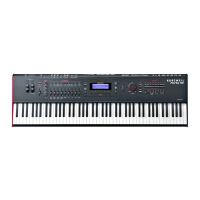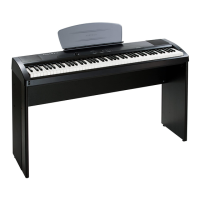The Effects Chain Editor
Effects Parameters
4-25
Ring Modulation
Ring modulation multiplies two signals (the “carrier” and the “modulator”) together to
produce unusual, often non-harmonic, overtones. e Ring Modulator eect in the PC4 has
two modes: “L*R” in which two mono signals are modulated together; and “Osc”, in which
the input is stereo, and it is modulated with the sum of ve waveforms that are generated
from oscillators within the eect itself. Four of these oscillators are sine waves, while one
(Oscillator 1) oers a selection of waveforms.
Wet/Dry. When the eect is in “L*R” mode, this controls how much of the left signal only is
passed dry (the right signal isn’t passed dry at all).
Mod Mode selects between the two modes, L*R or Osc.
Osc1 Lvl is the level of Oscillator 1, from 0 to 100%.
Osc1 Freq is the frequency of Oscillator 1, from 16 to 25088 Hz.
Osc1 Shape is the waveshape of Oscillator 1, selectable from Sine, Saw+, Saw-, Pulse, and
Tri.
Osc1PlsWid (Pulse Width). When Osc1 Shape is set to Pulse, this sets the pulse width as
a percentage of the waveform period. When the width is set to 50%, the result is a square
wave. is parameter has no eect if other waveform types are chosen. Range is 0 to 100%.
Osc1Smooth smooths (removes the higher harmonics from) the Saw+, Saw-, and Pulse
waveforms. A Sawtooth wave becomes more like a triangle wave, and a Pulse wave becomes
more like a sine wave. Range is 0 to 100%.
e other four oscillators, Sine2 through Sine5, each have Lvl and Freq controls.
Stereo Simulation
e Mono to Stereo eect converts a monaural input to simulated stereo output.
In Select selects the input signal to be “stereo-ized.” It can be Left, Right, or both: (L+R)/2.
CenterGain is the level of the summed left and right channels. Range is O/-79.0 to 24.0
dB.
Di Gain is the level of the dierence signal produced, which is the spatial component of
the stereo signal. Range is O/-79.0 to 24.0 dB.
DiBassG controls the gain of a bass-shelf lter on the dierence signal. By boosting the
low frequency components of the dierence signal, you can increase the sense of acoustic
envelopment. Range is -79.0 to 24.0 dB.
DiBassF is the transition frequency for the bass-shelf frequency. Range is 16 to 25088 Hz.
e processed signal is split into three frequency bands—Lo, Mid, and High—each of which
can be delayed and panned separately.

